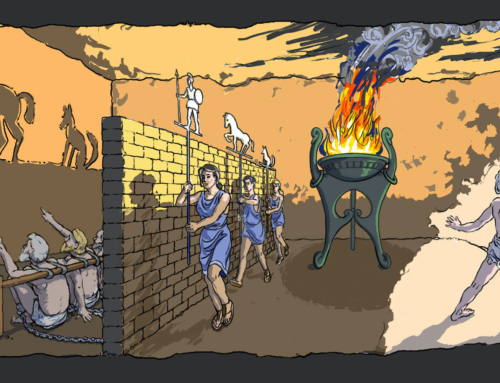Edith Stein and the problem of empathy
As a graduate student of the philosopher Edmund Husserl, Edith Stein decided to write her dissertation on empathy, the ability to become aware of what others are experiencing. At the outbreak of World War I, however, Edith Stein deferred her philosophical studies and volunteered as a nurse’s aide at a military hospital in Moravia.
 Far from distracting her from her philosophical pursuits, this time of service was a providential opportunity to learn more deeply the meaning of empathy. Each day, she assisted patients who were difficult to communicate with because of barriers of language and debilitation, trying to understand how and why they were suffering so as to be able to assist them or to communicate their symptoms to a doctor. According to Alasdair MacIntyre, this constant exposure to suffering and death helped Stein to later articulate in philosophical terms “what it is to be with and to be there for others, when they are confronting the possibility of imminent death.”
Far from distracting her from her philosophical pursuits, this time of service was a providential opportunity to learn more deeply the meaning of empathy. Each day, she assisted patients who were difficult to communicate with because of barriers of language and debilitation, trying to understand how and why they were suffering so as to be able to assist them or to communicate their symptoms to a doctor. According to Alasdair MacIntyre, this constant exposure to suffering and death helped Stein to later articulate in philosophical terms “what it is to be with and to be there for others, when they are confronting the possibility of imminent death.”
Several years later, while visiting the recently widowed Anna Reinach, Stein was astounded to find that though she had come to comfort her friend, it was in fact Reinach who comforted Stein. Years later, Stein was able to understand that this visit with Reinach, who had been baptized with her husband shortly before his death, was her “first encounter with the cross and the divine power that it bestows on those who carry it. For the first time I was seeing with my very eyes the church, born from its Redeemer’s sufferings, triumphant over the sting of death.”
Standing at the Cross with Our Lady: The Stabat Mater
On today’s feast of Our Lady of Sorrows, we are invited to consider another example of empathy, but one so powerful that it may be rather called compassion, which literally means “suffering with.” In the Gospel according to John, we hear that “near the cross of Jesus, there also stood his mother, and his mother’s sister, Mary the wife of Clopas, and Mary Magdalene” (John 19:25). The Latin text of this passage (“Stabant autem juxta crucem Jesu mater ejus”) inspired the Franciscan poet Jacopone da Todi to compose the sequence Stabat Mater dolorosa, which the Church has seen fit to employ as an official articulation of the mystery of Mary’s sorrow and suffering.
In this sequence, we first hear that Mary shares the sorrow of Christ, bearing his bitter anguish. Hers is not a physical suffering — she does not feel in her own body the scourges, the crown of thorns, or the beginning stages of asphyxiation — but is rather a spiritual suffering: the sword that Simeon prophesied would pierce her heart has now at length done so. In vivid terms, the sequence captures Mary’s distress:
Christ above in torment hangs,
She beneath beholds the pangs
Of her dying, glorious Son.
The sequence does not consist of a mere elaboration of Mary’s grief, but continues by inviting the singer and listener into this emotional experience of Mary.
O sweet Mother! fount of love,
Touch my spirit from above,
Make my heart with yours accord.Make me feel as you have felt;
Make my soul to glow and melt
With the love of Christ, my Lord.
Just as Mary participates in Christ’s sufferings by the strength of her empathy and compassion, the singer asks to be brought into an intimate relationship with Jesus precisely by participating in Mary’s vicarious suffering:
Holy Mother, pierce me through,
In my heart each wound renew
Of my Savior crucified.Let me share with you his pain,
Who for all our sins was slain,
Who for me in torments died.
The emotional balance of the liturgy
This powerful prayer offers us a precious glimpse into the spiritual power of empathy and compassion. However, as moving as this prayer is, it is important to note that the liturgy is not engaging in cheap emotional antics in order to manipulate us into a fleeting sense of our own guilt and a gelatinous purpose of amendment. When we consider the other elements of the liturgy of this feast, we may note a balance of expressions of the desolation of Mary at the foot of the cross and her present glory, assumed into heaven and crowned as queen of the universe. For instance, the Alleluia verse Stabat sancta Maria juxtaposes Mary’s present glory and the moment of Calvary: “Holy Mary, the Queen of heaven and Mistress of the world, filled with sorrow, stood by the cross of Our Lord Jesus Christ.”
The Offertory Recordare draws a parallel between Mary standing before Christ on the Cross and her present position standing before him in heaven: “Be mindful, O Virgin Mother of God, when you stand in the sight of the Lord, to speak good things for us, and to turn away his wrath from us” (cf. Jr 18:20). Her fidelity in standing by her son on Calvary gives her a special power of intercession for us as she stands in his sight today.
Finally, the traditional Communion antiphon Felices sensus paradoxically captures the joy and suffering of Mary: “Happy the senses of the Blessed Virgin Mary, which, without death obtained the palm of martyrdom beside the cross of the Lord.” This liturgy thus sings the gamut between desolation and gladness.
To Jesus through Mary
The Church’s liturgy proposes the person of Mary under the aspect of her sorrows once a year. In the meantime, rather than waiting listlessly for the next revolution of the globe, let us recall that the Rosary invites us to share in Mary’s emotions, inner thoughts, and experiences as we recollect the mysteries of the life of Jesus. By means of the marvelous human trait of empathy, we possess an effective way of growing closer to Jesus through Mary.







